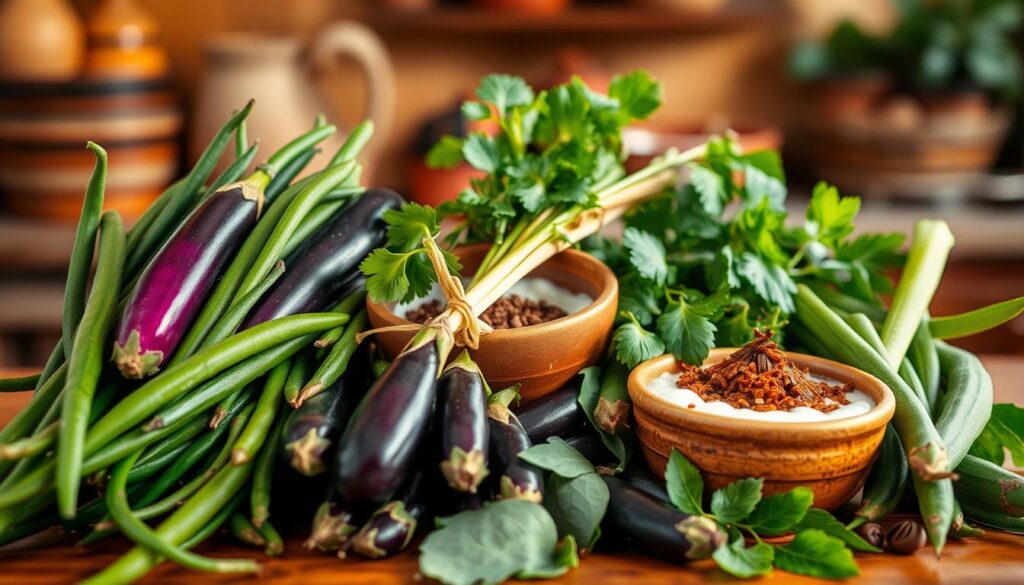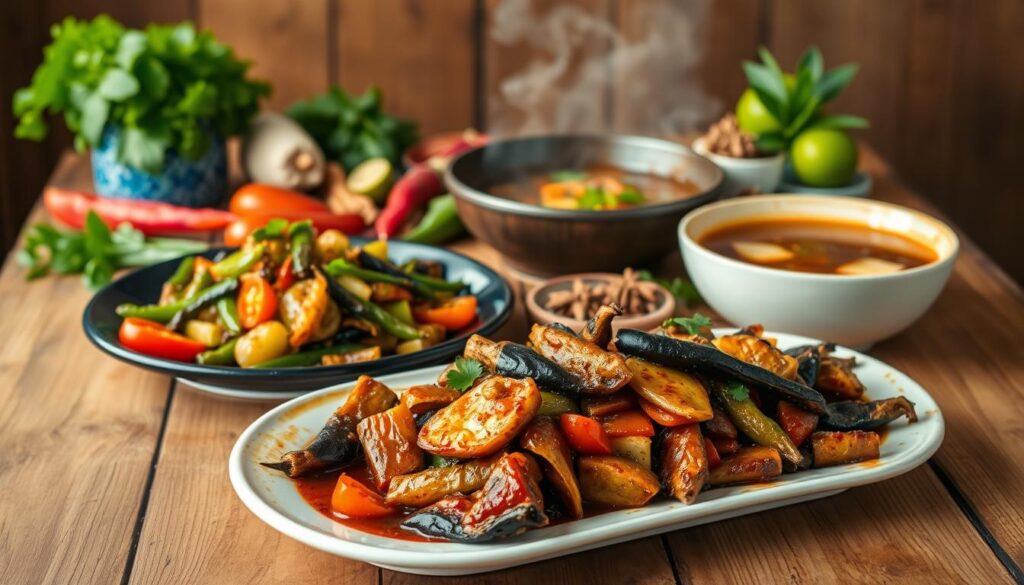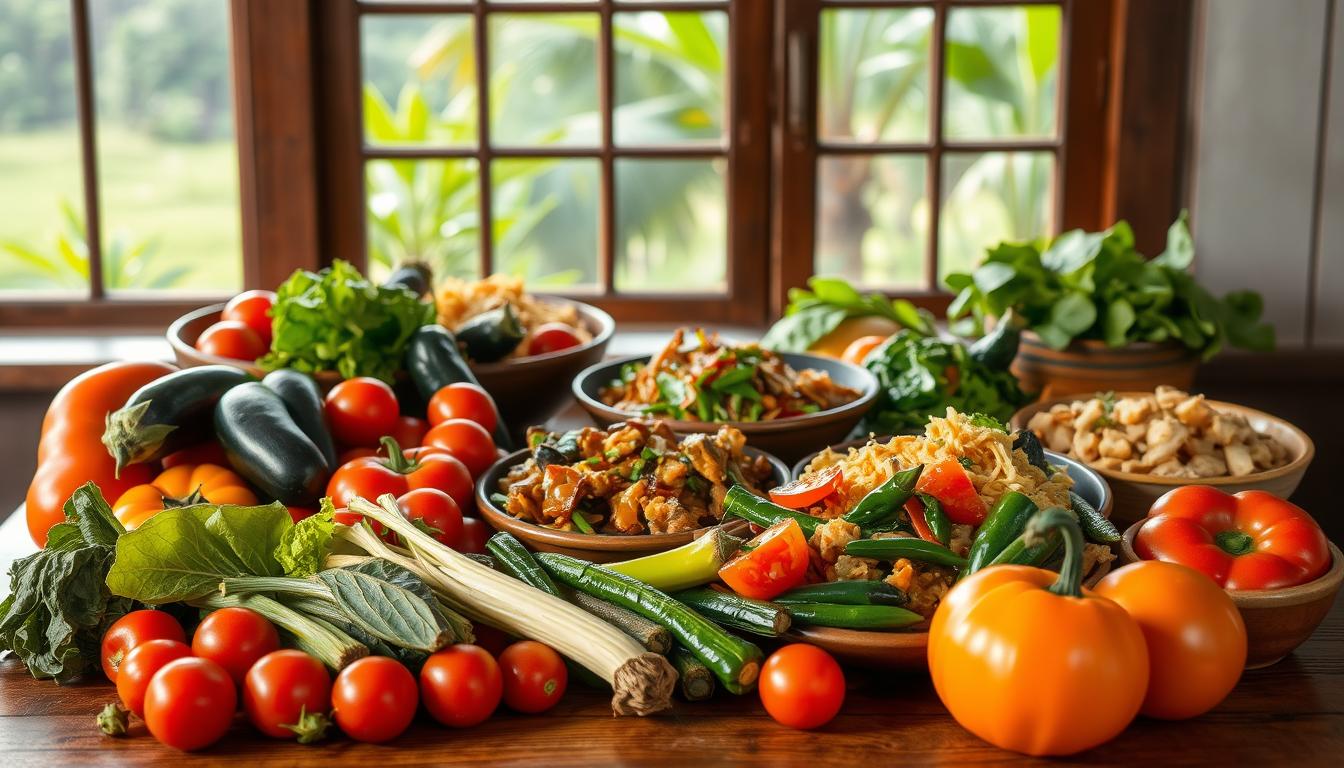Delicious vegetable dishes pinoy You’ll Love
What if the secret to vibrant, flavor-packed meals isn’t in fancy techniques but in humble, garden-fresh ingredients? Filipino cooking has long answered this question with dishes that turn everyday produce into unforgettable feasts.
From bustling Manila markets to quiet provincial kitchens, these recipes blend tradition with creativity—and they’re waiting to redefine how you think about plant-based meals.
Discover the best vegetable dishes Pinoy style. Explore our list of delicious Filipino vegetable recipes you can easily make at home.
Imagine kangkong (water spinach) stir-fried with garlic, or sitaw (long beans) simmered in coconut milk. These staples form the backbone of a cuisine shaped by centuries of cultural exchange. Spanish stews, Chinese wok techniques, and tropical flavors merge in dishes like pinakbet—a savory mix of squash, okra, and bitter melon—or laing, where taro leaves swim in spicy coconut broth.
What makes these recipes stand out? It’s not just the ingredients but the philosophy: nothing goes to waste. Stems, leaves, and even flowers find purpose here. Farmers’ markets overflow with kalabasa (squash) and malunggay (moringa), while home cooks transform them into meals that nourish families and communities alike.
Key Takeaways
- Filipino cuisine blends indigenous flavors with Spanish, Chinese, and American influences
- Fresh, affordable produce like bitter melon and moringa leaves are available year-round
- Distinctive use of coconut milk and fermented sauces creates rich, unique flavors
- Recipes emphasize sustainability by using every part of the plant
- Family traditions shape cooking methods, with recipes passed through generations
Introduction to Filipino Vegetable Cuisine
The heart of Filipino kitchens beats with a rhythm of sizzling pans and simmering pots where garden harvests meet bold flavors. This culinary tradition thrives on improvisation—transforming simple produce into meals that comfort families and spark conversations.
What Makes These Recipes Stand Out
You’ll taste history in every bite. Centuries of trade routes left their mark through Spanish saffron, Chinese wok techniques, and American-era canned goods. Local cooks masterfully blend these with native kalamansi citrus and banana blossoms.
Three elements define authentic preparations:
- Layered flavors: Garlic-onion-tomato bases build depth before adding bitter melon or winged beans
- Umami boosters: Fermented shrimp paste (bagoong) or fish sauce elevate even the simplest greens
- Texture play: Crispy chicharon toppings contrast with silky coconut milk stews
Core Components of Flavor
Your pantry needs two essentials: coconut milk for richness and vinegar for brightness. Northern regions lean on earthy ampalaya, while southern islands simmer gabi leaves in spicy coconut broth. Fresh herbs like pandan add floral notes to balance savory profiles.
Meals center around shared platters—think steamed rice surrounded by garlicky adobong sitaw beans and turmeric-laced squash stews. Every recipe whispers stories of home cooks who turned scarcity into abundance.
Exploring Traditional Filipino Vegetable Flavors
Every spoonful of traditional Filipino fare carries whispers of history. Centuries of cultural exchange shaped cooking methods that transform local harvests into bold, layered flavors. Let’s unpack how global influences and regional ingenuity created dishes that define communities.

Cultural Influences in Filipino Cooking
Spanish colonizers left more than churches—they brought sautéing (ginisa) and stewing techniques. These methods became the foundation for simmering squash in tomato-based sauces or caramelizing onions for adobo-style recipes.
Chinese traders introduced stir-frying and ingredients like tofu. Locals adapted these, creating togue guisado—mung bean sprouts wok-tossed with shrimp paste. American-era canned goods later inspired new combinations, like green beans stewed with tomato sauce.
Signature Dishes and Their Stories
Pinakbet Ilocano tells a northern story. Bitter melon, okra, and sweet potato mingle with fermented anchovy sauce, balancing earthiness with umami punch. It’s a farmer’s harvest perfected over generations.
Down south, Laing showcases Bicol’s love for heat and cream. Dried taro leaves steep in coconut milk, chili, and lemongrass—a dish born from monsoon-resistant crops. Families tweak spice levels, but the soul remains: resilience served steaming hot.
| Dish | Region | Key Ingredients | Flavor Profile |
|---|---|---|---|
| Pinakbet Ilocano | Northern Luzon | Bitter melon, okra, anchovy sauce | Bitter, salty, umami |
| Laing | Bicol Region | Taro leaves, coconut milk, chili | Creamy, spicy, earthy |
These recipes aren’t just meals—they’re edible archives. Each bite preserves the creativity of cooks who turned foreign techniques into something uniquely Filipino.
Essential vegetable dishes pinoy to Try at Home
Have you ever wondered how a single pot of stew could tell the story of an entire archipelago? Filipino home cooks have perfected four foundational meals that carry generations of wisdom. These creations balance land and sea, bitter and sweet, tradition and necessity.
Historical Background of Classic Recipes
Ginataang Sitaw at Kalabasa began in coastal communities where crabs supplemented garden harvests. Fishermen’s wives simmered blue crabs with squash and string beans in coconut milk—a thrifty way to stretch limited protein. Batangas farmers created Bulanglang as a light lunch using summer vegetables from overflowing markets.
Monggo Guisado’s roots trace back to resourceful cooks transforming humble mung beans into comfort food. Adding dried anchovies and malunggay leaves turned basic legumes into vitamin-packed meals during lean seasons. Northern Luzon’s Pinakbet evolved through Ilocano farmers’ need to preserve vegetables without refrigeration, using fermented shrimp paste as both preservative and flavor booster.
Ingredients and Flavor Profiles
Three elements define these staples: coconut milk’s creaminess, umami-rich sauces, and fresh produce at peak ripeness. Ginataang dishes rely on first-press coconut cream to coat string beans and squash with velvety richness. For Bulanglang, unripe papaya adds crunch while okra contributes its signature silky texture.
Mastering these recipes means learning techniques like salting bitter melon to soften its edge or layering ingredients by cooking time. Crisp green beans go in last during Pinakbet prep, while mung beans need thorough soaking before simmering. Each method ensures flavors meld while textures stay distinct—proof that tradition and practicality always share the pot.
Creative Twists on Classic Filipino Recipes
Filipino kitchens are buzzing with reinvention as chefs rework time-honored meals for modern palates. Bold flavor swaps and clever techniques breathe new life into familiar favorites while honoring their cultural roots.

Innovative Cooking Techniques
Air fryers now crisp tofu for Sisig without deep-frying, cutting oil by 70%. Steaming preserves the snap of green beans in Pancit Sotanghon, while pressure cookers slash simmering times for coconut-based stews.
Home cooks layer flavors using unconventional methods. Shiitake mushrooms get marinated in liquid smoke before stir-frying, mimicking pork’s richness in vegetarian Pancit Canton. Oven-roasted eggplant replaces meat in adobo variations, absorbing tangy vinegar-garlic sauces.
| Technique | Traditional Method | Modern Adaptation | Benefit |
|---|---|---|---|
| Frying | Deep-fried pork belly | Air-fried tofu cubes | Lower fat content |
| Broth Making | Chicken stock | Kombu seaweed infusion | Umami without meat |
| Fermentation | Fish sauce (bagoong) | Miso-turmeric blend | Plant-based saltiness |
Mixing Traditional and Modern Flavors
Korean gochujang now spices up ginisa bases, adding sweet heat to squash and string beans. Nutritional yeast stands in for fish sauce in vegan versions of Laing, keeping the dish’s earthy depth intact.
Cross-cultural fusions thrive. A popular Manila café serves Tofu Sisig tacos with pickled banana blossoms. Another spot reinvented Bulanglang as a grain bowl, pairing broth-poached okra with quinoa and tahini drizzle.
These adaptations prove tradition evolves. As one chef notes: “We’re not erasing history—we’re writing new chapters with the same ingredients.” From cashew cream sauces to jackfruit “adobo,” innovation ensures these recipes stay relevant across generations.
Cultivating the Perfect Balance of Health and Flavor
How do home cooks create meals that nourish the body and excite the palate? The answer lies in nature’s pharmacy—ingredients packed with vitamins and healing compounds. Filipino culinary traditions naturally merge wellness and taste through smart pairings of local harvests.
Nutritional Benefits of Fresh Vegetables
Mung beans do more than thicken stews. Their high fiber content aids digestion while antioxidants combat free radicals. A single serving delivers 50% of your daily folate needs, supporting cell regeneration.
Bok choy brings cancer-fighting power to stir-fries. Its vitamin C boosts immunity, while beta-carotene protects eye health. Taro leaves, star of laing, offer vitamin A for strong vision and B vitamins for nerve function.
Don’t overlook chayote. This squash cousin contains myricetin—a compound studied for blocking tumor growth. Its anti-inflammatory properties make it ideal for arthritis-friendly meals.
Customizing Recipes for Dietary Needs
Your dietary needs don’t mean sacrificing tradition. Swap fish sauce with mashed miso paste for lower sodium versions. Replace coconut milk with blended cashews when reducing saturated fats.
Diabetic-friendly adjustments are simple. Use chayote instead of potatoes in ginataang, cutting carbs by 40%. Increase protein by adding tofu cubes to monggo guisado without altering its earthy flavor profile.
Gluten-free? Skip soy sauce and amplify kalamansi citrus in marinades. Heart-healthy versions thrive on steaming techniques that preserve nutrients better than frying. Every modification keeps the soul of these meals intact while honoring your body’s needs.
Tips for Cooking, Storage, and Ingredient Substitutions
Ever wondered why some meals taste better the next day? Mastering storage methods and smart swaps can elevate your culinary results while preserving freshness. Let’s explore techniques that keep ingredients vibrant and flavors authentic.
Proper Storage Techniques for Fresh Produce
Keep ethylene-sensitive items like leafy greens away from apples or bananas. Store them in breathable containers lined with paper towels. For bitter melon, salt it for 10 minutes before rinsing—this cuts bitterness by 40% while keeping crunch intact.
Kitchen Hacks for Authentic Filipino Dishes
Soak minced garlic in vinegar to mellow its bite without losing aroma. Caramelize onions low and slow—45 minutes unlocks natural sweetness perfect for ginisa bases. No shrimp paste? Blend miso with lime juice for a vegan sauce alternative.
Freeze coconut milk in ice trays for portion-controlled creaminess. When substituting ingredients, match textures first: zucchini works in pinakbet if squash isn’t available. Remember—great dish outcomes start with how you handle your harvest.





